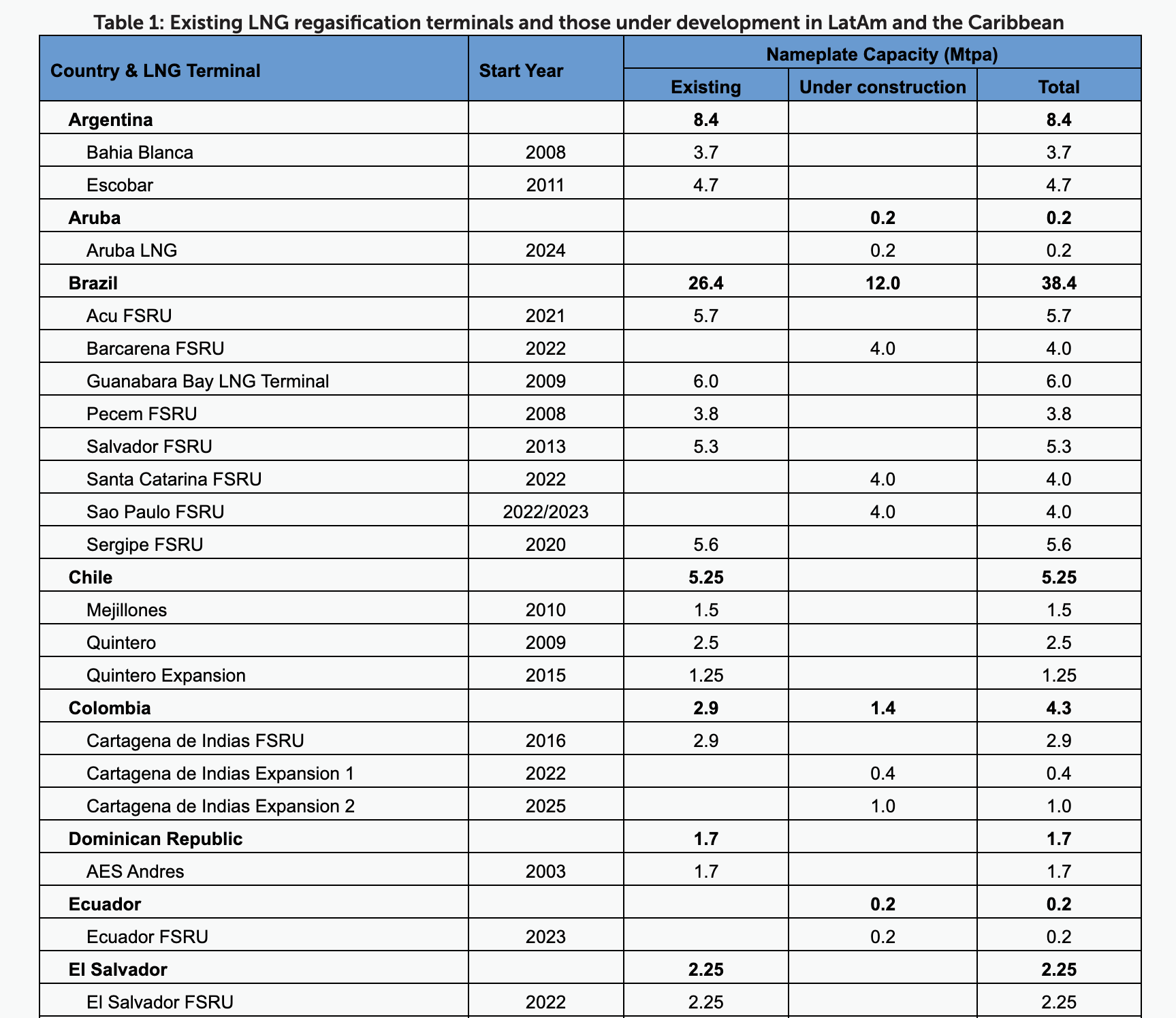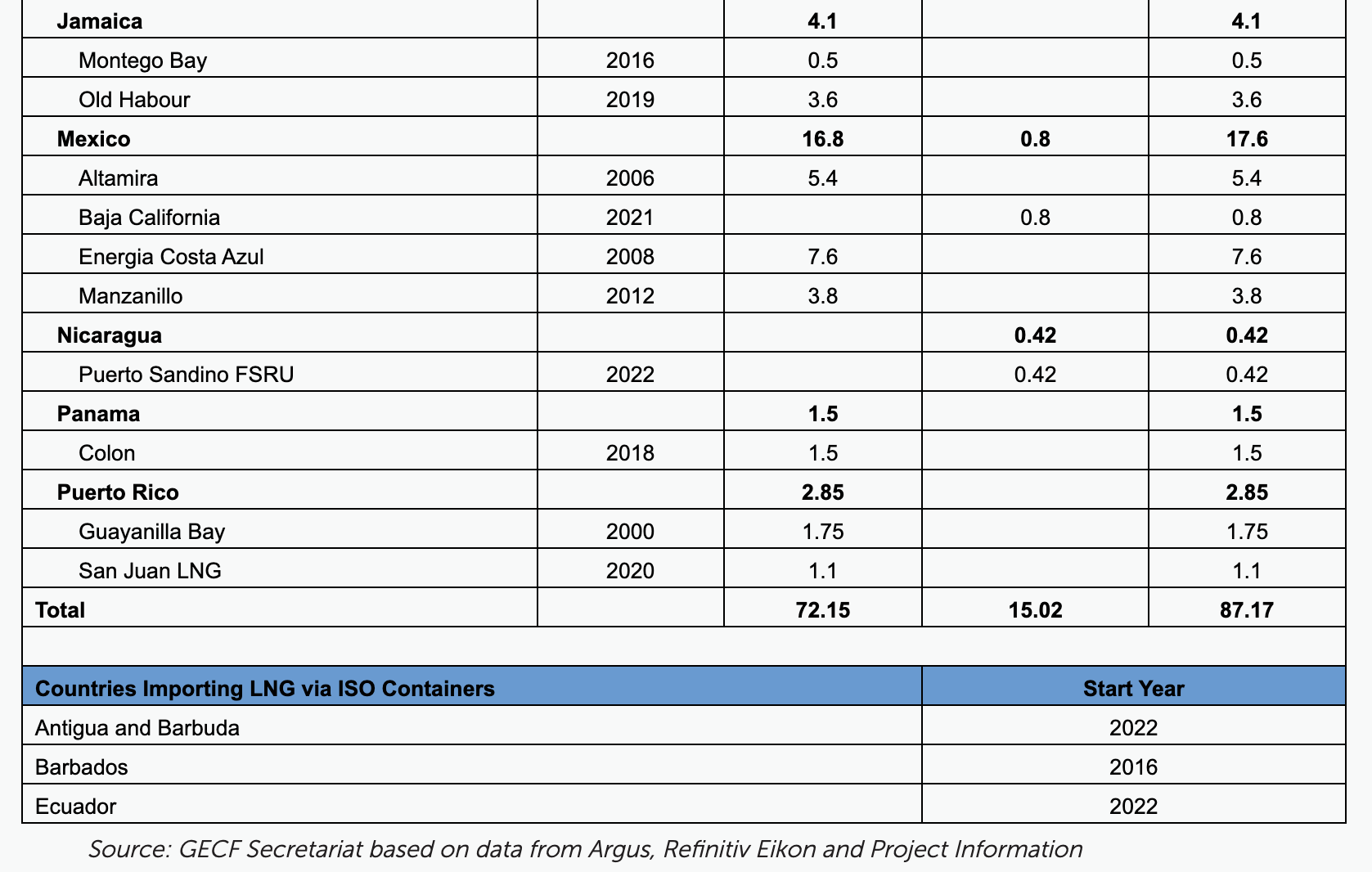The Latin America and Caribbean (LAC) region is primarily geared up to import LNG, not export it. The two exceptions are Peru with its Peru LNG facility and twin-island Trinidad and Tobago with its Atlantic LNG facility. But, in theory, proposed liquefaction projects could revert the LAC region’s import reality. To what extent it materializes in practice is another question.
Currently, the LAC region has regasification capacity of around 72 million tonnes per annum (mtpa), according to the Gas Exporting Countries Forum (GECF). And the countries with the largest populations and economies are home to the bulk of the LAC region’s regasification capacity. Brazil accounts for around 40% of this capacity; Mexico, 24%; and Argentina, 12%.
And at least 15 mtpa of regasification capacity is under construction, with 12 mtpa alone located in Brazil, according to the GECF, despite exploration successes in recent years in the prolific pre-salt region offshore. At most, Brazil needs to hedge its bets until it can build-up its domestic gas infrastructure. In the meantime, it needs assurance it can import gas if need be.
Despite this massive regasification capacity, actual and planned, the LAC region’s utilization capacity averaged around 25% in 2021, according to the GECF. The reasons vary across the LAC region’s big economies.
Argentina is boosting oil and gas production from its Vaca Muerta (“Dead Cow”) shale formation, albeit slowly due to infrastructure bottlenecks. Likewise, Brazil’s import dependency falls drastically when the country doesn’t experience drought conditions and its dams are sufficient to produce energy and reduce the need to import LNG. Brazil also still has access to piped-gas from Bolivia and potentially Argentina. Mexico is better located geographically, which affords it the easy access to cheap piped-gas from the U.S. Permian Basin.
Major headwinds
All told, LNG exporters face the threat of losing market share as LAC transitions from an LNG importing region to an exporting region.
But getting there will not be easy. Investors across Argentina, Brazil and Mexico will face political headwinds with changing governments and ideology-driven priorities, as well as economic and financial headwinds that encompass subsidies, overvalued currencies and repatriation of funds.
Another major consideration: international oil companies active in the LAC region are also changing priorities in response to the energy transition and the push to net-zero emissions.
Enter Argentina and Mexico with plans that could, in theory, anchor the LAC region’s emergence as an LNG exporter over the near-to-medium term.
Plans floated by Argentina’s state oil company YPF, in partnership with Malaysia’s Petronas, to move forward an LNG export project that could see the country add 25 mtpa of liquefaction capacity. Beyond the political, economic and financial constraints that confront Argentina’s national oil companies, the biggest below-surface headwind is a lack of infrastructure to move the country’s massive shale production to the coast for export.
Plans in Mexico to export LNG could see the country add 32 mtpa of liquefaction capacity, according to Rystad Energy, or up to 45 mtpa, according to BTU Analytics.
But unlike Argentina, Mexico has an advantage on two fronts.
First, the planned liquefaction projects have been proposed by private companies with foreign capital, a factor that boosts the potential of many of them to get across the finish line, since that would reduce the burden of state-owned Petroleos Mexicanos (Pemex) to fund infrastructure projects.
Second, the planned projects will source gas from the prolific U.S. Permian Basin, thus further reducing Pemex-related funding pressures to increase production to feed the projects.


But lurking in the region are Guyana and Suriname, neighboring countries in northern South America with plans to add significant liquefaction capacity in the future.
The potential to add liquefaction capacity in the LAC region is real. While Argentina and Mexico are seemingly moving the fastest with mega liquefaction potential, Brazil is not far behind. Then, there’s always the sleeping giant in the region, Venezuela, home to massive non-associated gas reserves but hampered by political stalemate, U.S. sanctions and all-around investor uncertainties.
So, what’s the likelihood that Argentina and Mexico achieve their goals?
It depends on the risk factor applied. My risk adjusted figures: 50% for Mexico and 30% for Argentina.
Recommended Reading
Texas LNG Export Plant Signs Additional Offtake Deal With EQT
2024-04-23 - Glenfarne Group LLC's proposed Texas LNG export plant in Brownsville has signed an additional tolling agreement with EQT Corp. to provide natural gas liquefaction services of an additional 1.5 mtpa over 20 years.
US Refiners to Face Tighter Heavy Spreads this Summer TPH
2024-04-22 - Tudor, Pickering, Holt and Co. (TPH) expects fairly tight heavy crude discounts in the U.S. this summer and beyond owing to lower imports of Canadian, Mexican and Venezuelan crudes.
What's Affecting Oil Prices This Week? (April 22, 2024)
2024-04-22 - Stratas Advisors predict that despite geopolitical tensions, the oil supply will not be disrupted, even with the U.S. House of Representatives inserting sanctions on Iran’s oil exports.
Association: Monthly Texas Upstream Jobs Show Most Growth in Decade
2024-04-22 - Since the COVID-19 pandemic, the oil and gas industry has added 39,500 upstream jobs in Texas, with take home pay averaging $124,000 in 2023.
Shipping Industry Urges UN to Protect Vessels After Iran Seizure
2024-04-19 - Merchant ships and seafarers are increasingly in peril at sea as attacks escalate in the Middle East.




